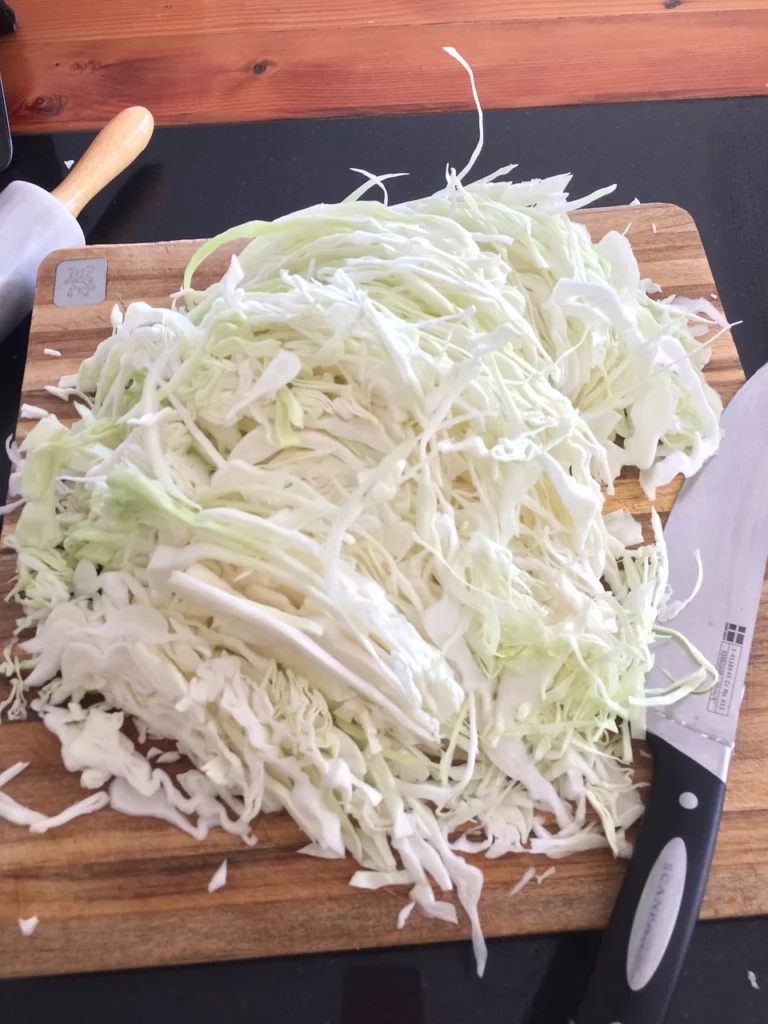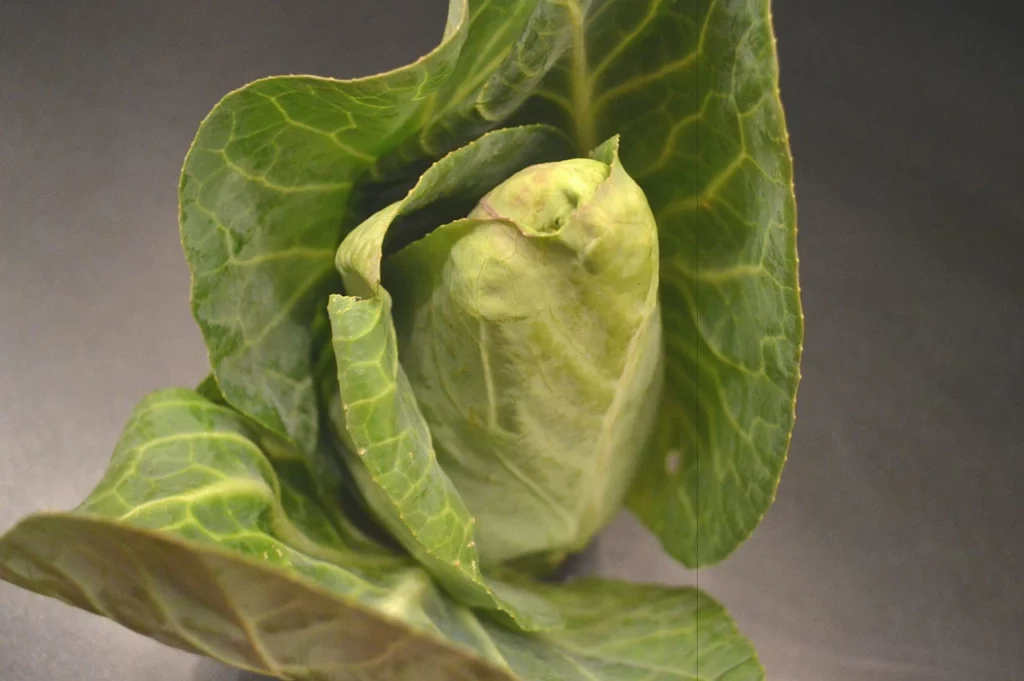The slender variety of white cabbage offers many advantages: pointed cabbage is particularly tender and well tolerated. It is also ideal for smaller gardens, because it does not take up as much space as other types of cabbage. In addition, you can make delicious sauerkraut with pointed cabbage. Why pointed cabbage should not be missing in your garden, you will learn in this article.
- At a glance
- Light: sunny to partial shade
- Water requirements: even water supply is important for healthy growth and tender leaves
- Nutrient requirements: high (heavy consumer)
- Soil: loamy to sandy, rich in humus
- Germination temperature: 16 – 20 °C
- Planting depth: 1 – 2 cm
- planting distance: early cabbage 40 x 40 cm, late cabbage 50 x 50 cm
- good neighbors: peas, potatoes, leeks, lettuce, celery, spinach, tomatoes, chamomile, coriander, caraway (herbs for aroma)
- bad neighbors: mustard, other types of cabbage, onions, garlic, beets, horseradish, tuber fennel.
Contents
The pointed cabbage plant
Normal cabbages are often very large plants, which leaves little space in the bed for other crops. This is exactly where the advantage of pointed cabbage lies: as a slimmer version of white cabbage, the cabbage head does not require as much space and can be combined well with other crops. It’s a great alternative for smaller gardens, too. Because of its smaller size, pointed cabbage takes less time to grow, which means it can be harvested relatively early (May). In addition, its leaves are more tender than those of the large white cabbage, making it particularly tasty and easier to digest. Therefore, however, the shelf life of pointed cabbage is not quite as good as that of other types of cabbage.
Locations for pointed cabbage
Pointed cabbage prefers full sun, but also does well in partial shade. Your bed should be well fertilized and mulched beforehand, because as a heavy grower, pointed cabbage needs plenty of nutrients. The soil should also be rich in humus and loamy. Consistent watering ensures good, healthy growth and particularly tender leaves.
Pre-growing pointed cabbage
The procedure for growing is similar to that for red cabbage, white cabbage and savoy cabbage. If you want to harvest already in May, you should start pre-growing in January. Pre-growing can also be done in February and March. For this purpose, it is best to choose suitable early varieties. The seeds are placed 1-2 cm deep in pots or multi-plates filled with growing soil. For germination, cabbage plants need a germination temperature of about 16-20 °C as well as sufficient light and moisture. Therefore, it is best to place the pots on a windowsill or in a heated greenhouse. From March you can plant them out with a planting distance of approx. 40 x 40 cm. Cover the sensitive young plants with a fleece at night to prevent them from freezing.
Direct sowing of pointed cabbage
Later summer varieties you can sow directly into the bed from April to early May. Late sowings can be harvested from June. There are also hardy varieties, such as ‘Duncan’, that you can sow in August. However, when sowing in mid-summer, it is essential to ensure regular watering so that the seeds germinate reliably and the young plants can develop healthily. Protect the cabbage plants in the fall with a fleece, so you can harvest them in the winter. About a month after sowing, you should prick out the young plants. These later varieties need a little more space than earlier ones. Therefore, make sure that the planting distance is 50 x 50 cm. Your pointed cabbage will be ready for harvest after about 100 days.
Care of pointed cabbage
To keep the leaves tender, water your cabbage plants regularly. Weed your bed regularly, so that the weeds do not take over. A layer of mulch is beneficial here, as it not only prevents weeds from growing, but also helps keep the soil moist. It is also important to keep enough space between plants, otherwise the heads will be small and the plants will be more susceptible to disease. Here are a few more tips to avoid cabbage diseases:
Algal lime into the planting hole against cabbage hernia.
Mix with tomatoes and celery to prevent cabbage whitefly infestation
good neighbors: peas, potatoes, leeks, lettuce, celery, spinach, tomatoes, chamomile, coriander, caraway (herbs for aroma)
bad neighbors: mustard, other cabbages, onions, garlic, beets, horseradish, bulbous fennel
crop rotation: cultivation break of at least 4 years in the same bed
Fertilize pointed cabbage
Before planting, you should prepare your bed with organic fertilizer. You can use rotted manure and horn meal for this purpose. Compost alone is often not enough as a source of nutrients for cabbage, so you can mix it with horn shavings. A thicker layer of mulch (e.g., from dried lawn clippings) also provides nutrients. During the growth phase you can fertilize with nettle manure and rock flour. Organic liquid fertilizer also supports the growth of your plants.
Pointed cabbage varieties
Early varieties (harvest from May):
‘Erstling’: particularly early and fast-growing variety that can be preseasoned as early as January.
‘Berns’: medium-early variety with gray-green leaves
Late varieties (harvest from September):
- ‘Filderkraut’: medium-late, very sugary variety, good for sauerkraut production
- ‘Duncan’: can be grown all year round, particularly robust
- ‘Kalibos’: cross between pointed and red cabbage, resulting in red-purple and loose heads
Harvesting and storing pointed cabbage
Between May and December is the harvest season of pointed cabbage. Once the head has reached the desired size, you can cut it with a sharp knife just below the stalk. You should remove the root later to prevent diseases from lingering in the soil. Alternatively, you can pull the head and root out of the ground. Pointed cabbage cannot be stored for long because of its tender leaves. Wrapped in a damp cloth and placed in a cool place, a head of cabbage can be stored for about 1- 2 weeks. However, you can preserve your cabbage very easily by fermenting it and turning it into sauerkraut. Freezing is not recommended for raw leaves, they should be blanched briefly beforehand. This preserves the flavor, firmness and vitamins better.

Diseases of pointed cabbage
As with all cabbage varieties, pointed cabbage can be attacked by the caterpillars of the cabbage white butterfly. The moth lays eggs under the leaves of the cabbage. Once the caterpillars hatch, they begin to systematically eat away at the leaves, causing the plant to die in extreme cases. Especially if you apply nettle manure in your garden to strengthen your plants, the white moth will be attracted. You can prevent the infestation by planting tomatoes and celery next to your cabbage. The intense odor of the neighbors will mask that of the cabbage and the butterflies will not find their oviposition site. Also, regularly check the undersides of the leaves of young plants, because that is where the butterfly attaches its eggs. If you plant later in the season, you can mulch with tansy or peppermint if available – both plants repel the butterflies. But you can prevent infestations not only on a biological level; the pests can also be kept away mechanically through crop protection nets.
However, if it is already too late and the caterpillars are already there, it is worthwhile to collect them manually at an early stage. You can also use ichneumon wasps as beneficial insects in your garden, as they are natural enemies of the cabbage white butterfly. These biological pest controllers can be ordered from various online stores.
If your cabbage plants are affected by mildew, you can water them with horsetail liquid manure. This is very easy to make. You need horsetail, water and a bucket. Then you can proceed according to the same principle as with the stinging nettle liquid manure. To prevent the fungus, it may also be worthwhile to mix the crop with garlic.
Cabbage hernia is also a typical disease of all cruciferous plants (Brassicaceae). The fungal disease causes cabbage to grow worse and later, even with adequate watering, the leaves droop and turn yellow. You can avoid this by rotating your cabbage plants, that is, not replanting in a spot where cabbage has grown before. After about 4 years, the soil will have regenerated and you can plant your cabbage plants there again. If you have symptomatic wilted cabbage plants in your garden despite having kept the crop rotation, dig them up and check the roots. A typical characteristic are bulbous thickenings. To be absolutely sure that it is really the fungus, you must cut the thick roots. If they are hollow, it is probably the cabbage gall weevil. If the roots are white and not hollow, it is most likely the cabbage hernia fungus. In both cases, unfortunately, you should dispose of your plants as soon as possible, otherwise other plants may be infested. But beware: the cabbage hernia fungus can also survive in the compost and later infect your plants again. Therefore, it is better to dispose of infected plants in the household waste.
Propagate cabbage
Normally, head cabbage species like pointed cabbage are biennial plants. This means that in the first year they form the head with which the plant overwinters. Then, in the second year, the seed head develops, which can be harvested after flowering. However, today’s cultivars are poor at overwintering in the field, so most gardeners:inside prefer to buy cabbage seeds. Two methods have become established in the hobby: One is to dig up the entire plant and plant it in pots, tubs or boxes in a basement. However, here you need to water from time to time. In addition, the heads, especially savoy cabbage, quickly begin to rot, which means that old leaves need to be cleaned off regularly. As a second option, the heads can be harvested when transplanting in the fall and only the stalks can be stored in containers for the winter. In this case, the interfaces should be additionally dusted with ash or charcoal to prevent disease attack on the stalks. A little soil mixed with wood shavings is suitable as a substrate. The wood shavings hold water well, so watering is rarely needed. You will achieve greater overwintering success if you take your plants outside on bright and frost-free days, or place them in a bright cellar window.


